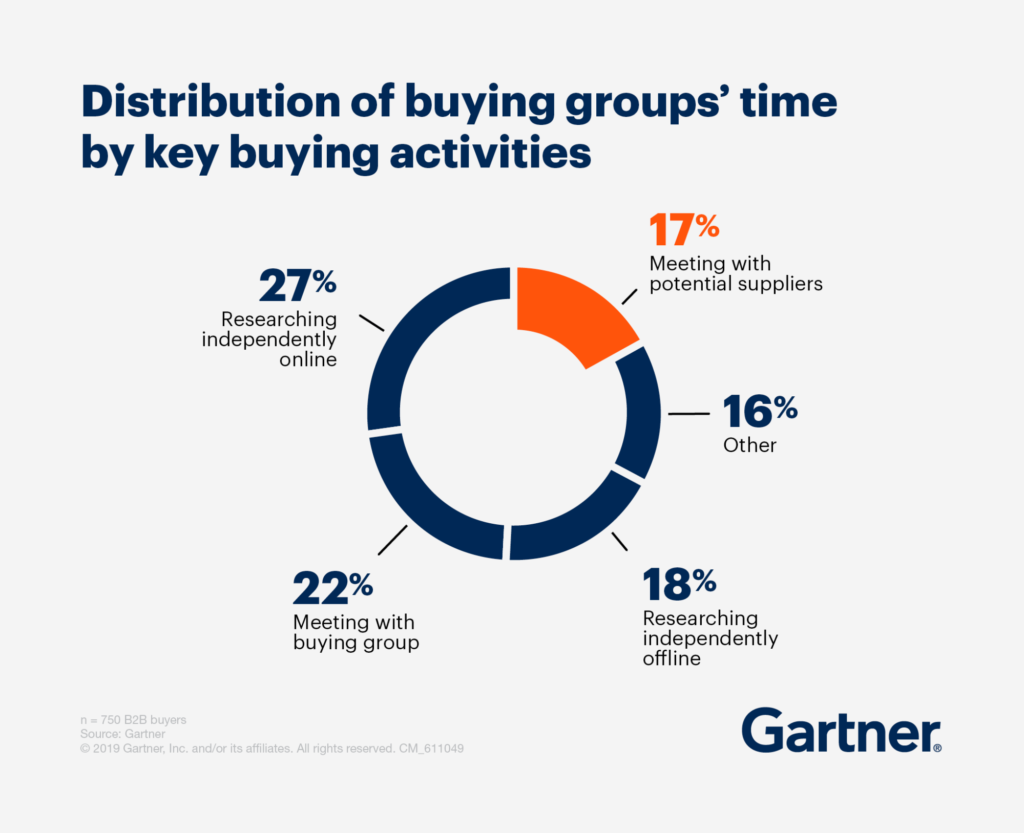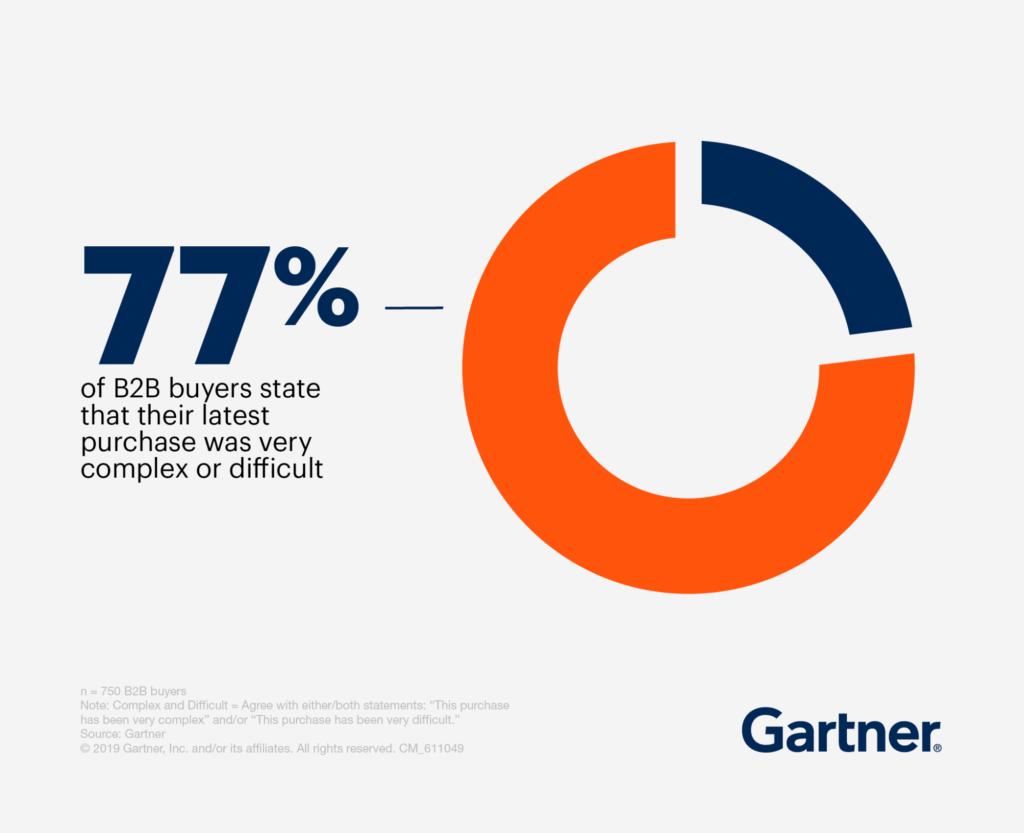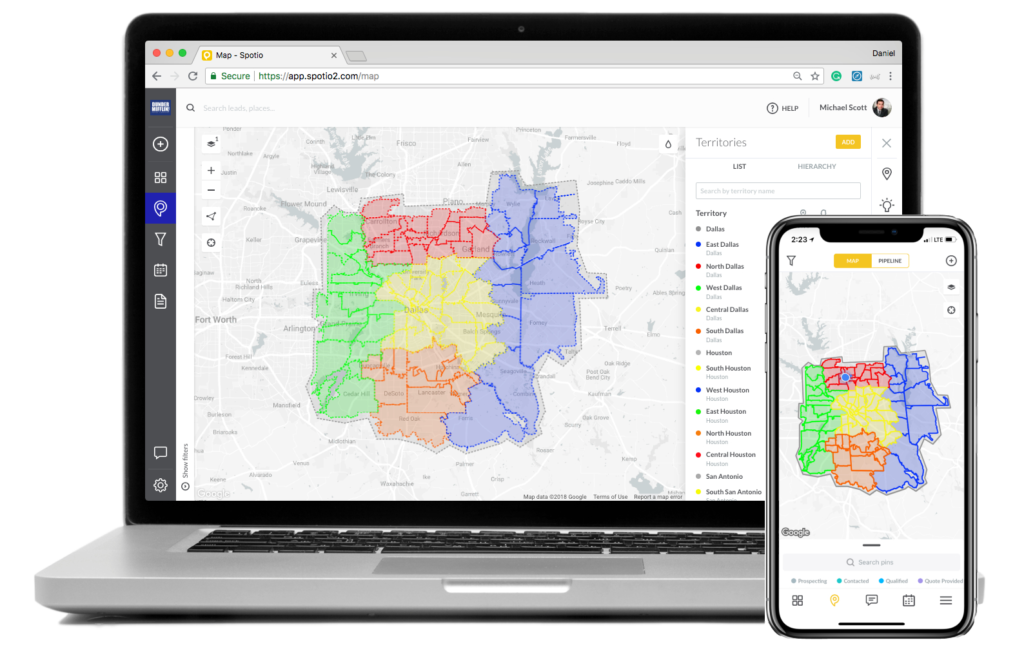Sales Tactics
Building a strong sales process is the lifeblood of any business.
Sales tactics are the techniques managers and reps use to achieve lofty sales goals. They not only help close deals, but fill your pipeline with a steady stream of qualified prospects and opportunities.
Today, there are countless sales tactics at your disposal.
To help you succeed, we’ve compiled 23 proven sales tactics that work across any industry or vertical.
But first, let’s take a look at why you need these tactics.
The Modern Buyer Journey Has Changed
The buyer’s journey has changed.
And that’s mostly down to the Internet.
Buyers now have a wealth of information readily available, and that puts them in control of the purchasing decision as they can use digital channels at all stages of their buying journey.
Longer sales cycle
Previously, the buying process was linear. The typical stages were Awareness, Consideration, and Decision. Buyers moved along in an orderly fashion through the sales funnel:

Now, it’s more of an iterative process where buyers circle back to look at all the options and confer with other decision makers:

All these extended activities mean the buyer’s journey is longer.
More educated
The availability of online content also means buyers are more educated and informed about their options than ever before. According to a study by Accenture 94% of B2B buyers conduct online research at some point in the buying process.
As a result, buyers are quite happy to conduct initial research online and only connect with a sales rep later on in their journey to confirm their findings.
According to Gartner, when B2B buyers are considering a purchase, they spend only 17% of that time meeting with potential suppliers. And when they’re comparing multiple suppliers‚ they spend only 5% or 6% of their time with each sales rep.

More decision makers
Furthermore, the buyer’s journey has become more complicated because there is more than one person involved in the decision: The typical buying group for a complex B2B solution involves six to 10 decision makers.
Each person reports back to the group with several solutions to consider. And to make things more complicated, there are more technologies and products on the market.

This is why it’s more important than ever for sales teams to be equipped with the best sales tactics so they can efficiently and effectively navigate the complexity of a modern buyer journey.
23 Field-Tested Sales Tactics That Work in 2021
The following sales tactics can work for sales teams in every industry, across each stage of the sales cycle:
- Prospect
- Engage
- Close
- Follow Up
Let’s start with prospecting…
Prospect
Prospecting is the process of searching for and identifying potential new customers for a business. It involves cold-calling as well as reaching out to nurture leads that have gone cold.
More than 40% of salespeople say prospecting is the most challenging part of the sales process, followed by closing (36%) and qualifying (22%):

But just because it’s difficult doesn’t mean you can ignore it. The most successful salespeople are those who block time off for prospecting. Setting aside dedicated time in your calendar each day results in more conversations and better win rates.
Deeply Understand Your Ideal Customer
To have any success with prospecting, you need to understand who your ideal customer is. Unfortunately at least 50% of your prospects are not a good fit for what you sell.
It’s pointless chasing prospects that are a bad fit from the start. So make sure your prospects fit your ideal customer profile by verifying these key areas:
Demographics
- Where are they located?
- What industry/niche are they in?
- Are they the right-sized company?
Needs/pains
- What are they struggling with?
- How will your product or service solve their problem?
- How will they measure results?
Decision-making process
- Discover who makes the buying decisions?
- How many people are involved in the decision-making process?
- How long do they take to make a decision?
- Which events or triggers lead them to buy (or not buy) your type of products or services.
Know Your Competition Inside Out
If you’re going to succeed with a prospect, you need to know what competition you’re up against. It could be one or more similar vendors, or it might be an internal team. Research their history to see what vendors they used previously and find out if they’re likely to buy from you.
Map Territories
Sales territory mapping lets you create and assign specific territories to each rep, whether they’re working on inside or outside sales. With territory mapping software like SPOTIO, you can:
- Define regions that meet your ideal customer criteria.
- Allocate them across your sales team to avoid any overlapping and poaching.
Qualify Prospects
Not all leads are created equal. The net result is sales reps wasting their valuable time on worthless leads:
- 67% of lost sales are a result of sales reps not properly qualifying potential customers before taking them through the full sales process.
- 61% of B2B marketers send all leads directly to Sales; however, only 27% of those leads will be qualified.
Ensure your sales team is only “working” the most qualified prospects (SQLs) to save time, energy, and money – and boost conversion rates.
Engage
These next set of sales tactics are all designed to help you engage your prospects.
Develop a Script
Ring DNA defines sales scripts as a “prescribed set of talking points” that telemarketers and sales reps use when speaking to prospects.
Telemarketers tend to stick to a rigid script that forks in different directions according to the prospect’s responses.
But for sales, a script should act as a ‘crib sheet’ and prepare you with the best questions and lines to ask.
Scripts can be used in different scenarios such as cold calling, leaving a voicemail, and writing emails. But whatever the situation, HubSpot recommends following this framework:
- Identify a product or service to focus on
- Hone in on your target audience
- Develop your benefits
- Link your benefits to pain points
- Ask questions about those pain points: How do you feel about the amount of time it currently takes you to fill open positions? How many sales opportunities do you lose each month due to poor lead tracking and follow up? How much lost revenue would you say that equates to each month?
- Don’t talk too much
- Always close for something
True Needs Assessment
Salespeople love to talk – mainly about themselves and their company – when they’d be better off listening to their prospect’s needs. That’s why there’s often a disconnect, and sales reps fail to engage buyers:

The Sandler Pain Funnel is a method of asking open-ended, needs-based questions to uncover the prospects pain:
The pain questions start broad; e.g. “What are some things you would like to change about your current system/provider/product line?” and then move to more specific questions; e.g. “How long has that been a problem?” and “How much do you think that cost you?”
By asking open-ended questions and listening to your prospect’s answers, you can get to the root of what they actually need.
Contact Leads Within 5 Minutes
How long do you wait before contacting new prospects?
Velocify research found that timing is critical if you want to increase your chances of conversion. Placing a phone call to a new prospect within a minute of lead generation can increase your likelihood of conversion by nearly 400%.

While research by Lead Response Management found that the first 5 minutes are critical:
You are 100x more likely to successfully contact a lead if you respond within 5 minutes and 21x more likely to qualify that lead.
Warm Up Cold Prospects
There aren’t many salespeople who like cold calling. However, there are a few tactics you can use to warm up your prospects.
- Talk about the prospect and listen to what they have to say.
- Balance the conversation with useful information you possess; e.g. pricing, special offers, etc.
- Consider the technique of trend, solution, and proof.
For example:
Mention a pertinent industry trend:
“The biggest challenge will be in three years when fossil fuel resources are low…”
Suggest a few possible solutions or recommendations:
“Our clients are preparing for this by upgrading their engineering systems to be more self-sufficient.”
Prove you can do it:
“We’ve done this for several manufacturing companies including [client name], and they’ve seen excellent results, which is why I’m calling you.”
Follow Up Across Multiple Channels
It’s not often that a sales rep connects with a prospect the first time.
Research from TOPO found it takes an average of 18 calls to connect with a buyer. And only 23.9% of sales emails are opened.
That’s why it’s essential to use more than one channel to follow up and engage with your prospects. In the same way that buyers use digital channels to research and select vendors, sales teams can use technology to reach prospects.
For instance, an HBR study found that 40% of sales people that regularly use LinkedIn indicated they have successfully generated revenue from the social network.
Call From A Local Number
What’s your reaction when you check the caller display on incoming calls?
If the number is blocked or toll-free, then you probably feel suspicious and are reluctant to take the call.
Contrast that to a local number. How do you feel now? I bet you’re more inclined to pick up and answer.
Research by Software Advice shows that people are nearly four times more likely to answer calls from local numbers:

That’s why you should apply the same logic when you dial potential buyers.
Put Boots On The Ground
With the wealth of digital channels available, is there still a place for outside sales teams?
- Out of the 5.7 million professional salespeople in the U.S., approximately 47.2% are inside sales professionals, and 52.8% are outside sales reps.
Plus, there are a couple more factors to consider:
- Companies who have a majority of outside sales reps have a 30.2% higher close rate than companies who have a majority of inside sales reps.
- Deals worked by outside sales teams tended to be 130.2% bigger on average than those worked by inside sales teams.
Depending on your industry, it’s worth considering using both inside and outside sales teams to complement your strategy.
Assign Territories (Strategically)
Sales territory management is the process of using data to segment customers and prospects to ensure the best use of company resources. Strategic sales territory management aligns salespeople with the most appropriate customer base – whether that’s by geography, vertical, expertise, or past relationship.
The old-fashioned way of creating and assigning territories involved drawing outlines on physical maps by hand. But SPOTIO’s Territory Manager software enables managers to create custom maps of different territories and assign them strategically to sales reps.

For instance, managers can assign their top performing reps to the most important territories and customer accounts. Plus, having a clear picture of the territory assignments avoids any redundancy in sales activity.
Provide Sales Enablement Materials
Sales enablement materials come in various formats, including:
- Blog posts
- Whitepapers
- Case studies
- Email templates
- Sales scripts
- Presentation slides
- Product info sheets
- Competitor/Product comparisons
- Social media messages
- Customer testimonials
- Video content – demo or how to
- Printed brochures
However, the content created for sales enablement is different from content created for content marketing purposes.
According to Seismic, content created to attract leads and convert them into prospects is content for marketing purposes, while content created for the conversion and closing stages of the sales funnel is classified as sales enablement content.
That’s not to say salespeople should ignore the marketing content. When marketing and sales are aligned, high-quality educational content can be used to address potential customer questions at each stage of the buyer journey.
It’s a case of using the right content, at the right time.
Be Consistent
If you want to be successful, you need to be consistent. Set aside time each day for specific sales activities like prospecting, following-up, and nurturing to build relationships with your potential buyers.
Salespeople who leave everything to the last moment and try to cram in last-minute calls in the hope of clinching a deal fall short of their targets.
Close
When it’s time to close the deal you’ve been working on, try these sales tactics.
Let Prospects Sell Themselves
Sometimes you’re in that situation where you believe you’ve done everything right and your potential customer is ready to buy. Only for them to raise more questions like: “What can you do for me?” and “Can you cut me a special deal?”
At this stage, the best thing you can do is let the prospect sell themselves. How? – By asking questions to take control of the conversation.
Instead of trying to convince your prospect, get your prospect to tell you what they want and why your product or service is the right one for them.
Prepare For, And Handle, Key Objections
Sooner or later, you’re going to get a “No.” But what do you do when your prospect raises an objection.
First, be prepared for objections. You should expect them, and you should be ready to handle them when they come. Think of objections as an excellent opportunity to close the deal.
Second, prepare some answers. Depending on your industry and product/service, you’ll know some of the objections you’re likely to face.
Here are 10 examples of sales objections and how to overcome them.
Customize Your Pitch
Before you even pick up the phone to make a call or visit an office to make a presentation, remember you’re dealing with a real person. It’s imperative to do your homework and understand the individual you’re pitching.
Research the prospect on LinkedIn, check out their work history and where they fit in at their current organization. Check other social media channels to see where their out-of-work interests lie.
When you know these details, you can customize your pitch to meet their requirements.
As ClickTime’s head of sales, Bill Mooney says: “That means positioning your solution not just how you see it working for your prospect’s business, but in a way that solves the problem they personally care about most too.”
If you want to be successful in sales, realize that you’re selling to people, not companies.
Always Be Closing
The ABC for salespeople is Always Be Closing. It’s the make-or-break moment in the sales process. But which closing technique should you use.
Here are three for starters:
Assumptive Close
If you have a good relationship with your prospect, then you can use the Assumptive Close method. The technique is based on them trusting you. So as you walk through their requirements, list the items they want on the order form, and then, when the time is right, present it to them to sign.
Ben Franklin Close
The Ben Franklin closing technique is especially useful with prospects who aren’t sure or have trouble making decisions. It’s so-called because the Founding Father was fond of making a list of Pros and Cons, and then going with the longest list.
You can use this technique when a prospect is sitting on the fence. Just make sure your list of Pros is longer.
Puppy Dog Close
The Puppy Dog Close plays on the idea that folks who take a puppy home for a few days are unlikely to return it because they simply adore it.
In other words, let your prospect have a “free trial” or “test drive” of your product knowing they’ll fall in love with it and agree to buy it.
| BONUS RESOURCE: 16 Sales Closing Techniques Reps Should Add to Their Arsenal (with Examples) |
Following Up & Referrals
A referral is a sales lead that comes from a customer. And they’re the best leads you can get.
According to the Wharton School of Business, a referred customer has a 16% higher lifetime value than a non-referred customer.
But when and how should you ask for them?
Ask for Referrals After Delivery, Not Closing
There’s a right and wrong time to ask your customer for a referral. Many salespeople jump straight in after closing a deal.
But think about it.
You’ve just gained a customer, but you haven’t delivered the product or service yet.
Therefore hang fire on the request until you have proven you can deliver. Either stay in touch with the customer and check they’re happy with the service. Or, as Geoffrey James recommends, ask for the “right to ask.”
Both of these options give your new customer the chance to consider the most applicable referrals based on your sales and service.
Make it Super Easy
If you make it super easy for your customers to refer you to someone else, they’ll likely do it quicker and more often.
One way to make it easy for them is to create an introduction email template that they can forward on your behalf.
Here’s an example from HubSpot:
|
Use Timing to Your Advantage
You should always be on the lookout for an opportunity to ask for a referral. For instance, when a customer praises you in an email, posts an update about your product or service on social media, or makes a LinkedIn recommendation, then strike while the iron’s hot and ask them for a referral!
Recognize and Thank Your Referral Sources
Once a customer refers you, remember to thank them. Give them a call or send a note expressing your gratitude, and chances are they’ll refer you to more prospects.
Conclusion
The buyer’s journey has changed. The sales cycle takes longer as buyers take more time to research products and services before contacting a sales rep.
The question is: are you ready? By using these proven sales tactics, you’ll be able to close more deals and get more prospects.
_______
SPOTIO is the #1 field sales engagement platform to increase your revenue, maximize your profitability, and increase your team’s productivity.
Want to see a product demonstration? Click here to see how SPOTIO can take your sales game to the next level.




